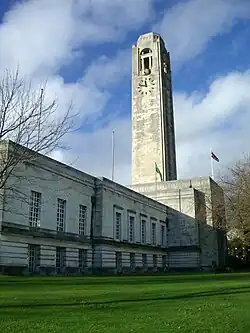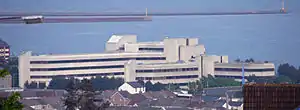City and County of Swansea Council
The City and County of Swansea Council (Welsh: Cyngor Dinas a Sir Abertawe), or simply Swansea Council (Welsh: Cyngor Abertawe), is the local authority for the city and county of Swansea, one of the principal areas of Wales. The principal area also includes rural areas to the north of the built-up area of Swansea and the Gower Peninsula to the west. The council consists of 75 councillors representing 32 electoral wards.
Swansea Council Welsh: Cyngor Abertawe | |
|---|---|
 | |
| Type | |
| Type | |
| History | |
| Founded | 1 April 1996 |
| Preceded by | West Glamorgan County Council Swansea City Council Lliw Valley Borough Council |
| Leadership | |
Martin Nicholls since 21 November 2022[2] | |
| Structure | |
| Seats | 75 councillors |
Political groups |
|
Length of term | 5 years |
| Elections | |
| First past the post | |
First election | 4 May 1995 |
Last election | 4 May 2017 |
Next election | 5 May 2022 |
| Meeting place | |
 | |
| Guildhall, Swansea | |
| Website | |
| www | |
Since 2012 the council has been controlled by the Labour Party.
History

Swansea was an ancient borough. The town's first charter was granted sometime between 1158 and 1184 by William de Newburgh, 3rd Earl of Warwick. The charter granted the townsmen (called burgesses) certain rights to develop the area. A second charter was granted in 1215 by King John. The borough was reformed under the Municipal Corporations Act 1835 to become a municipal borough.[3]
When elected county councils were established in 1889 under the Local Government Act 1888, Swansea was considered large enough to run its own county-level services, and so it became a county borough, independent from Glamorgan County Council. Swansea County Borough Council was the local authority from 1889 until 1974. It gained city status in 1969, allowing the council to call itself Swansea City Council.
In 1974, under the Local Government Act 1972, Swansea became a lower-tier district council, with the new West Glamorgan County Council providing county-level services. The district of Swansea created in 1974 was larger than the old county borough, also covering the area of the abolished Gower Rural District. In 1996, under the Local Government (Wales) Act 1994, further local government reform saw West Glamorgan County Council abolished and the district of Swansea merged with parts of the Lliw Valley district to form a unitary authority, called the 'City and County of Swansea' (Welsh: Dinas a Sir Abertawe.)
Political control
The first election to the new council was held in 1995, initially operating as a shadow authority before coming into its powers on 1 April 1996. Political control of the council since 1996 has been held by the following parties:[4]
| Party in control | Years | |
|---|---|---|
| Labour | 1996–2004 | |
| No overall control | 2004–2012 | |
| Labour | 2012–present | |
Leadership
The first leader of the council following the reforms in 1996, Tom Jones, was the last leader of West Glamorgan County Council. The leaders of Swansea Council since 1996 have been:[5]
| Councillor | Party | From | To | |
|---|---|---|---|---|
| Tom Jones | Labour | 1 Apr 1996 | 1999 | |
| Mike Hedges | Labour | 1999 | 18 May 2001 | |
| Lawrence Bailey | Labour | 18 May 2001 | 24 Jun 2004 | |
| Chris Holley | Liberal Democrats | 24 Jun 2004 | 15 May 2012 | |
| David Phillips[6] | Labour | 15 May 2012 | 28 Aug 2014 | |
| Rob Stewart[7] | Labour | 9 Sep 2014 | ||
Composition
Following the 2022 election the composition of the council was:
| Party | Councillors | |
|---|---|---|
| Labour | 45 | |
| Liberal Democrats | 11 | |
| Conservative | 7 | |
| Independent | 5 | |
| Uplands | 4 | |
| Independents@Swansea | 2 | |
| Green | 1 | |
| Total | 75 | |
The next election is due in 2027.
Elections
Since 2012, elections have taken place every five years. The last election was 5 May 2022.
| Year | Seats | Labour | Liberal Democrats | Conservative | Plaid Cymru | Green | Independent | Notes |
|---|---|---|---|---|---|---|---|---|
| 1995 | 72 | 57 | 6 | 1 | 0 | 0 | 8 | Labour majority controlled |
| 1999 | 72 | 45 | 11 | 4 | 3 | 0 | 9 | Labour majority controlled |
| 2004 | 72 | 32 | 19 | 4 | 5 | 0 | 12 | No overall control, "Swansea Administration" coalition[8][9] |
| 2008 | 72 | 30 | 23 | 4 | 1 | 0 | 14 | No overall control, "Swansea Administration" coalition[10] |
| 2012 | 72 | 49 | 12 | 4 | 0 | 0 | 7 | Labour majority controlled[11][12] |
| 2017 | 72 | 48 | 7 | 8 | 0 | 0 | 9 | Labour majority controlled[13] |
| 2022 | 75 | 45 | 11 | 7 | 0 | 1 | 11 | Labour majority controlled |
Party with the most elected councillors in bold. Coalition agreements in notes column.
Between 1996 and 2004, the council was under Labour control. Between 2004 and 2012 there was no overall control and the council was led by a coalition of the Liberal Democrats, Independents and the Conservatives, termed the Swansea Administration. Labour regained control of the council at the 2012 election and retained control at the 2017 and 2022 elections.
Mayoralty
.jpg.webp)
The Lord Mayor of Swansea (Welsh: Arglwydd Faer Abertawe) is a senior member of the elected Council. Swansea has had a Mayor since it became a borough in 1835. The dignity of Lord Mayor was conferred on the city by Queen Elizabeth II on 22 March 1982 to celebrate the wedding of Charles, Prince of Wales. The status was confirmed on 1 April 1996 when the Unitary Authority of the City and County of Swansea came into being.
The style of the Lord Mayor is "The Right Worshipful the Lord Mayor of Swansea". The official residence is the Mansion House in Ffynone, which was originally built as the home of a previous mayor, Evan Matthew Richards. It was purchased by the then County Borough of Swansea in 1922 and renamed the Mansion House.
Lord Mayors of Swansea
| Municipal Year | Mayor | Notes |
|---|---|---|
| 2023–24 | Graham Thomas | |
| 2022–23 | Mike Day | |
| 2021–22 | Mary Jones | |
| 2020–21 | Mark Child | |
| 2019–20 | Peter Black | |
| 2018–19 | David Phillips | |
| 2017–18 | Philip Downing | |
| 2016–17 | David Hopkins[14] | |
| 2015–16 | John Newbury[15] | |
| 2014–15 | Ceinwen Thomas[16] | |
| 2013–14 | June Stanton[17] | |
| 2012–13 | Dennis James | died 20 April 2013 |
| 2011–12 | Ioan Richard | |
| 2010–11 | Richard Lewis | |
| 2009–10 | Alan Lloyd | |
| 2008–09 | Gareth Sullivan | |
| 2007–08 | Susan Waller (Thomas) | |
| 2006–07 | Christopher Holley | |
| 2005–06 | Mair Gibbs | |
| 2004–05 | Margaret Smith | |
| 2003–04 | Lawrence Bailey | |
| 2002–03 | June Burtonshaw | |
| 2001–02 | Robert Francis-Davies | |
| 2000–01 | John Davies | |
| 1999–2000 | Robert J. Lloyd[18] | |
| 1998–99 | David I. E. Jones[18] | |
| 1997–98 | Gareth Williams[18] | |
| 1996–97 | Desmond Thomas/Len Howell | |
| 1995–96 | Grenville Phillips | |
| 1994–95 | Walter Dyer | |
| 1993–94 | Robert Davies | |
| 1992–93 | Charles Birss | |
| 1991–92 | Byron Owen | |
| 1990–91 | Colin Hammacott | |
| 1989–90 | Lorna Aldron | |
| 1988–89 | Howard John Morgan | |
| 1987–88 | Holland William Ayres | |
| 1986–87 | Lilian Maud Hopkin | First female Lord Mayor |
| 1985–86 | Trevor Gordon Burtonshaw | |
| 1984–85 | Michael Murphy | |
| 1983–84 | Charles Thomas | |
| 1982–83 | Tyssul Lewis | |
| 1982 | Paul Valerio | First Lord Mayor of Swansea |
Electoral divisions
Following a local government boundary review, the number of wards in Swansea was reduced from 36 to 32. The changes took effect from the 2022 local elections. The boundaries of 15 wards remained unchanged, but a number of other wards were merged, or radically altered, with new wards such as Mumbles and Waterfront created.[19]
The following table lists the post-2022 county/community wards, the numbers of councillors elected and the communities they cover. Communities with a community council are indicated with a '*':
* = Communities which elect a community council
c = Ward coterminous with community of the same name
Corporate identity
Logo
The logo of the City and County of Swansea depicts a stylised Osprey. It is shown with the name of the council written beneath it or beside it, both in Welsh (Cyngor Abertawe) and English (Swansea Council). An older version of the logo displayed the text written in a ring around the Osprey pictogram.
Coat of arms
The official coat of arms used by the council today were granted by the College of Arms in 1922. The motto is 'Floreat Swansea'.
The Arms are blazoned as follows:
- Per Fess wavy Azure and barry wavy of six Argent, of the first a double-towered Castle or, in Chief on an Inescutcheon of the third a Lion passant guardant Gules; And for the Crest, On a Wreath of the Colours an Osprey rising holding in the Beak a Fish proper; Supporters: on the dexter side a Lion Gules gorged with a Mural Crown or, and on the sinister side a Dragon Gules gorged with a Mural Crown or'.
The Arms are symbolic to an extent: the blue and white wavy bars represent the sea, since Swansea is a port town; the Castle represents the Medieval fortifications of the Town; the lion as dexter supporter and on the Inescutcheon commemorates the link with the de Breos family; and the dragon as sinister supporter is the National Emblem of Wales and is a supporter in the Achievement of Arms of the present Lord Swansea.
In April 1974, the City of Swansea was merged with the Gower Rural District to form the new District and City of Swansea. The Arms granted to the Corporation of the County Borough of Swansea in 1922 were transferred unchanged to the new City Council in May 1975. The Certificate of Transfer of the College of Arms dated 11 March 1976 confirmed the re-granting of the Arms. With the 1996 reorganisation of local government, the arms were transferred a second time to the present City Council.[20]
Council premises

- Civic Centre, formerly West Glamorgan County Hall
- Guildhall
- Mansion House
- Palace Theatre, Swansea
References
- "Council minutes, 19 May 2023" (PDF). Swansea Council. Retrieved 12 July 2023.
- Gregory, Rhys (23 November 2022). "Swansea Council has appointed a new Chief Executive". Wales 247. Retrieved 12 July 2023.
- "Swansea County Borough". A Vision of Britain through Time. GB Historical GIS / University of Portsmouth. Retrieved 30 October 2022.
- "Compositions calculator". The Elections Centre. Retrieved 30 October 2022.
- "Council minutes". Swansea Council. Retrieved 30 October 2022.
- "Swansea council leader David Phillips steps down". BBC News. 28 August 2014. Retrieved 30 October 2022.
- "Rob Stewart set to lead Labour-ruling Swansea council". BBC News. 2 September 2014. Retrieved 28 July 2019.
- "Swansea council - Lab lose to NOC". BBC News. 11 June 2004.
- "Local Election Results 2004 - Swansea". Local Elections Archive Project (Andrew Teale).
- "Local Election Results 2008 - Swansea". Local Elections Archive Project (Andrew Teale).
- "Vote 2012 - Swansea". BBC News. 4 May 2012.
- "Local Election Results 2012 - Swansea". Local Elections Archive Project (Andrew Teale).
- "Labour increases Swansea lead and holds Neath Port Talbot". BBC News. 5 May 2017.
- "New Lord Mayor for Swansea". City of Swansea. Archived from the original on 9 August 2017. Retrieved 9 August 2017.
- "Lord Mayor of Swansea". City of Swansea. Retrieved 14 December 2015.
- "Ceinwen Thomas installed as the new mayor of Swansea". South Wales Evening Post. Retrieved 13 October 2014.
- "New Lord Mayor and Deputy Lord Mayor for Swansea". South Wales Evening Post. Retrieved 30 April 2014.
- "Records relating to the Mayor/Lord Mayor of Swansea". Swansea City Council. Archived from the original on 1 May 2014. Retrieved 30 April 2014.
- Richard Youle (30 June 2021). "Swansea is to have three more councillors next year as some boundaries change". Wales Online. Retrieved 22 May 2022.
- The Local Authorities (Armorial Bearings) (No. 2) (Wales) Order 1996 (1996 No. 1930 ) (OPSI website), accessed October 2, 2007